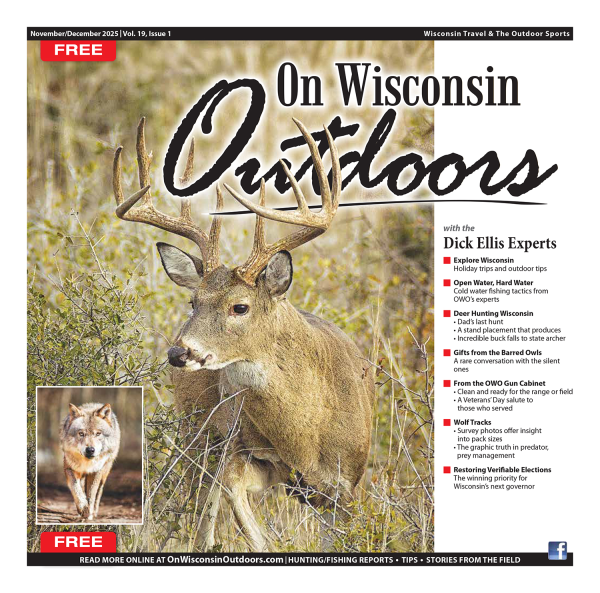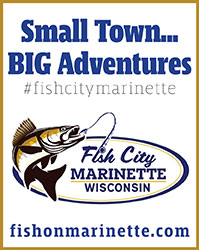DNR Weekly News Update for March 19, 2019
Published - March 19, 2019 by the Central Office
A rare Wisconsin songbird flies into the record books again
Contact(s): Davin Lopez, DNR, 608-266-0837; Sarah Warner, FWS, 608-238-9333 ext. 130
MADISON - Wisconsin conservation biologists are eagerly awaiting the return of Kirtland's warblers, hopefully including an Adams County bird that flew to fame in 2015 when researchers found it wintering 1,500 miles away in the Bahamas.
The bird has since returned to Adams County at least three times to nest and been a father twice over, adding to Wisconsin's growing population of this endangered species and knowledge about the rare songbird's habits and habitats.

Rare Wisconsin songbird flies into the record books again
"We're looking forward to seeing if he comes back in 2019," says Davin Lopez, the Department of Natural Resources conservation biologist leading DNR's efforts.
"This bird has been doing exactly what we want him to do: return to his hatch site and have a family. He also has been an excellent scientific subject, showing the value of the information we can learn from banding and monitoring," Lopez adds.
The bird hatched in 2014 in Adams County, and was one of six fledglings to have bands attached to their leg that year to help track if the young warblers would return to the breeding site in following years. The bird became known as ABPI, short for the color and order of the bands on his leg (Aluminum, Blue, Purple, Indigo).
Ashley Olah, the DNR nest monitor that summer, subsequently sighted the bird on Cat Island on April 6, 2015, in the Bahamas, where she was working as part of a Smithsonian Institute research team surveying for the rare songbird.
The discovery was the avian equivalent of finding a needle in a haystack, and now, four years later, ABPI remains the first, and only Kirtland's warbler to date that was banded in Wisconsin and sighted again in the Bahamas.
ABPI was not found in Wisconsin that summer, but returned to its Adams County hatch site in 2016, 2017 and 2018 and had successful nests of its own in 2017 and 2018, according to Sarah Warner, the biologist leading the U.S. Fish and Wildlife Service's banding and conservation efforts in Wisconsin.
"The life history data we have for ABPI is rare for most ornithological banding studies," Warner says. "Without banding and other monitoring efforts in place for the Wisconsin program, we never would have known his wintering site, his longevity, and his strong site fidelity," Warner says. "Site fidelity" means the bird returns to its hatch site.
Funding for the monitoring program was provided by the Natural Resources Foundation of Wisconsin.
More good news for the Kirtland's warbler
That ABPI returned to Wisconsin again in 2018 and successfully nested was just one piece of good news for Kirtland's warblers, according to the recently released 2018 nesting season report on the FWS's Wisconsin Kirtland's warbler web page (exit DNR).
Wisconsin's Kirtland's warbler population has continued to increase and geographically expand in response to partners' conservation efforts, growing from 11 birds and three nests documented in 2007 to 51 birds and 16 total nests in 2018.
In addition to monitoring and nest protection, partners have maintained and expanded the pine barrens habitat Kirtland's warblers need. Pine barrens are a globally rare type of savanna that support many other rare or declining plant and animal species, including the state endangered sand violet and the federally endangered Karner blue butterfly.
The number of Kirtland's warblers in Wisconsin doesn't yet meet the criteria to be removed from the state's endangered species list; however, the U.S. Fish & Wildlife Service is expected to announce this spring if the bird will be removed from the federal endangered and threatened species list. The species has met federal recovery goals following years of intensive habitat management, mostly in lower Michigan where the core population is found.
Please visit the Kirtland's Warbler Conservation Team (exit DNR) website for more information.
________________________
Citizen scientists asked to lend their ears for frog and toad conservation
Contact(s): Andrew Badje, DNR conservation biologist, 715-921-5886
Annual Wisconsin Frog and Toad Survey starts in April
MADISON - Each spring for the past 35 years a small army of citizen scientists (or froggers, as they proudly call themselves) head out into the darkness to survey seasonal wetlands, marshes, lakes, and rivers to help DNR conservation biologists document the breeding calls of frog and toads throughout Wisconsin.
"Once again, it's time for volunteers to lend us their ears," says Andrew Badje, the DNR conservation biologist who coordinates DNR's Wisconsin Frog and Toad Survey. "The information volunteers provide is essential to monitoring and conserving frog and toads in Wisconsin."

Volunteers sought for frog survey
Volunteers can participate in three separate but related efforts; more details are available on the Wisconsin Frog and Toad Survey web site (exit DNR):
- The traditional longstanding survey requires driving along a pre-set route for three nights, once each in early spring, late spring, and early summer. Volunteers make 10 stops per night (five minutes at each site) and document the species heard calling and the relative abundance of each species. See available 2019 survey routes (exit DNR).
- Phenology surveys help monitor when frogs and toads first start calling each spring and summer. Phenology volunteers choose one wetland to monitor throughout the frog calling season and record data as often as possible for five minutes per night.
- Finally, more volunteers are needed for a special effort to survey mink frogs, which often call in the daytime. Volunteers are recruited to listen twice during the day and twice at night along set routes in June and early July.
The Wisconsin Frog and Toad Survey was launched in 1984 amid concerns of declining populations of several species of frogs. Through the survey, citizen scientists have helped DNR conservation biologists define the distribution, status, and population trends of all 12 frog and toad species in the state.
"Our froggers have also really become advocates for frogs and toads," Badje says. "They survey upwards of four routes in all corners of the state, bring their children and grandchildren on fun nighttime frog calling excursions, and provide numerous frog and toad educational presentations at local libraries and nature centers.
"A few hardy 'uberfroggers' have even been surveying for 38 years, longer than I've been alive," Badje says. "With this level of enthusiasm, there is no doubt why this survey is the longest running citizen science amphibian calling survey in North America."
Citizen scientists are essential to understanding frog populations in Wisconsin
Since volunteers started collecting data in 1984, they've spent more than 9,200 nights surveying 91,000 sites, Badje says. "Without the level of monitoring volunteers can help provide, DNR would have a more difficult time assessing how well our current conservation measures are working."
Volunteers are currently documenting the highest levels of American bullfrogs and Blanchard's cricket frogs since the survey began, a sign that proactive conservation measures for these two species are likely paying off.
Volunteers have been instrumental in documenting new populations of Blanchard's cricket frogs along the Mississippi River in recent years, and in places they haven't been documented in over 30 years.
And volunteer data has documented a long-term decline for the northern leopard frog over the 35-year survey, while showing that spring peepers, boreal chorus frogs and green frogs have been on more stable paths since the survey began.
Read more about the survey and its results in the April 2016 Wisconsin Natural Resources magazine.
________________________
Wisconsin's National Archery in the Schools Program tournament to be held in the Dells
Contact(s): Daniel Schroeder, DNR NASP coordinator, 608-235-4619
MADISON - Nearly 1,600 of Wisconsin's youth archers are set to gather March 29-30 to aim for top honors at the 2019 Wisconsin National Archery in the Schools Program (NASP) state tournament at Wisconsin Dells.
The annual event will be held at the Woodside Convention and Expo Center. The tournament is open to the public and free for all spectators.
Daniel Schroeder, coordinator of the department's NASP, says the tournament offers fun, exciting views for spectators.
"These competitors in grades 4 through high school travel from 66 Wisconsin schools. They are serious about their archery skills and it is exciting to watch them compete," Schroeder said.
Athletes and their families travel from all over the state to compete for awards and to qualify for the NASP national tournament held each year in Louisville, Kentucky.
Schroeder says the program offers school children a chance to experience a sport they may not have known was available to them. "This program is growing because the schools are dedicated, getting more students into the sport," he said. "Students who may not see themselves as competitive athletes have found their sport - and it is confidence builder in academics and beyond."
The Wisconsin Dells state tournament also will feature a competitive NASP/IBO 3-D animal range, a bow fishing shooting area and several exhibitors.
Through NASP, archery is typically taught during the school day as part of a physical education curriculum. Every student uses identical, universal fit, equipment and is taught safety, proper form, shooting and scoring arrows and much more. Interested teachers can attend a one-day training session to receive Basic Archery Instructors certification. Archery equipment and a teaching curriculum is provided, and grants are available to help offset any initial startup costs for schools. With the grants, schools can get started with minimal investment and budget strain.
For more information, visit the DNR website, dnr.wi.gov, and search keyword "NASP" or visit naspschools.org (exit DNR).











